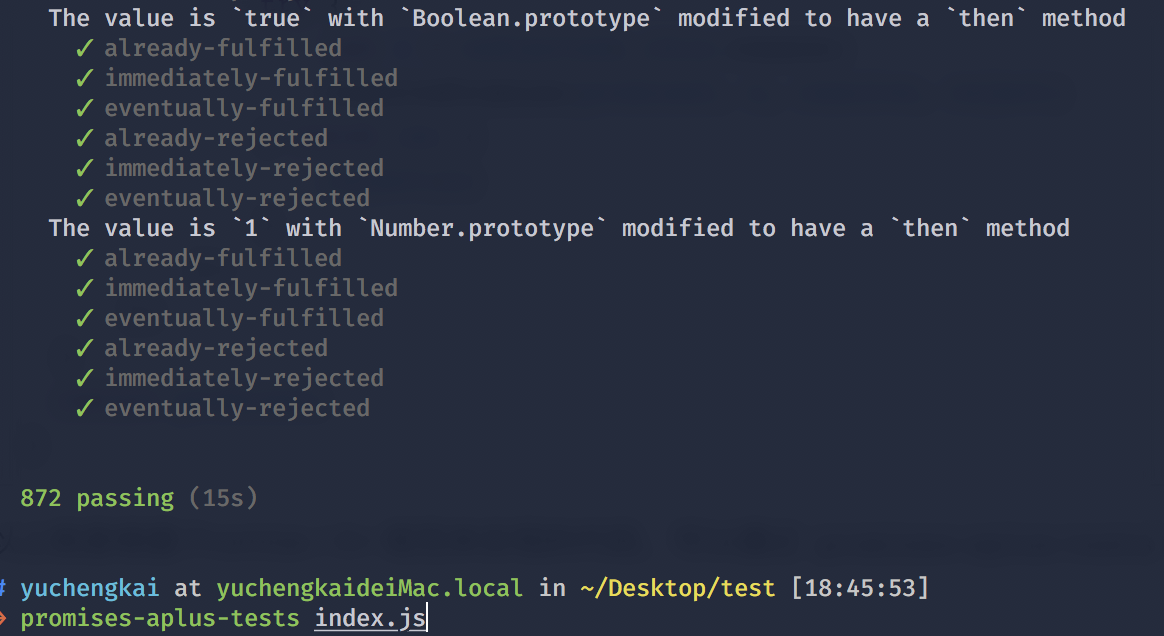Proxy
Proxy 是 ES6 中新增的功能,可以用来自定义对象中的操作
let p = new Proxy(target, handler); // `target` 代表需要添加代理的对象 // `handler` 用来自定义对象中的操作
可以很方便的使用 Proxy 来实现一个数据绑定和监听
let onWatch = (obj, setBind, getLogger) => { let handler = { get(target, property, receiver) { getLogger(target, property) return Reflect.get(target, property, receiver); }, set(target, property, value, receiver) { setBind(value); return Reflect.set(target, property, value); } }; return new Proxy(obj, handler); }; let obj = { a: 1 } let value let p = onWatch(obj, (v) => { value = v }, (target, property) => { console.log(`Get '${property}' = ${target[property]}`); }) p.a = 2 // bind `value` to `2` p.a // -> Get 'a' = 2
async 和 await
一个函数如果加上 async ,那么该函数就会返回一个 Promise
async function test() { return "1"; } console.log(test()); // -> Promise {<resolved>: "1"}
可以把 async 看成将函数返回值使用 Promise.resolve() 包裹了下。
await 只能在 async 函数中使用
function sleep() { return new Promise(resolve => { setTimeout(() => { console.log('finish') resolve("sleep"); }, 2000); }); } async function test() { let value = await sleep(); console.log("object"); } test()
注
上面代码会先打印 finish 然后再打印 object 。因为 await 会等待 sleep 函数 resolve ,所以即使后面是同步代码,也不会先去执行同步代码再来执行异步代码。
async 和 await 相比直接使用 Promise 来说,优势在于处理 then 的调用链,能够更清晰准确的写出代码。缺点在于滥用 await 可能会导致性能问题,因为 await 会阻塞代码,也许之后的异步代码并不依赖于前者,但仍然需要等待前者完成,导致代码失去了并发性。
下面来看一个使用 await 的代码。
var a = 0 var b = async () => { a = a + await 10 console.log('2', a) // -> '2' 10 a = (await 10) + a console.log('3', a) // -> '3' 20 } b() a++ console.log('1', a) // -> '1' 1
对于以上代码你可能会有疑惑,这里说明下原理
- 首先函数 b 先执行,在执行到 await 10 之前变量 a 还是 0,因为在 await 内部实现了 generators ,generators 会保留堆栈中东西,所以这时候 a = 0 被保存了下来
- 因为 await 是异步操作,遇到await就会立即返回一个pending状态的Promise对象,暂时返回执行代码的控制权,使得函数外的代码得以继续执行,所以会先执行 console.log('1', a)
- 这时候同步代码执行完毕,开始执行异步代码,将保存下来的值拿出来使用,这时候 a = 10
- 然后后面就是常规执行代码了
Map、FlatMap 和 Reduce
Map 作用是生成一个新数组,遍历原数组,将每个元素拿出来做一些变换然后 append 到新的数组中。
[1, 2, 3].map((v) => v + 1) // -> [2, 3, 4]
Map 有三个参数,分别是当前索引元素,索引,原数组
['1','2','3'].map(parseInt) // parseInt('1', 0) -> 1 // parseInt('2', 1) -> NaN // parseInt('3', 2) -> NaN
FlatMap 和 map 的作用几乎是相同的,但是对于多维数组来说,会将原数组降维。可以将 FlatMap 看成是 map + flatten ,目前该函数在浏览器中还不支持。
[1, [2], 3].flatMap((v) => v + 1) // -> [2, 3, 4]
如果想将一个多维数组彻底的降维,可以这样实现
const flattenDeep = (arr) => Array.isArray(arr) ? arr.reduce( (a, b) => [...a, ...flattenDeep(b)] , []) : [arr] flattenDeep([1, [[2], [3, [4]], 5]])
Reduce 作用是数组中的值组合起来,最终得到一个值
function a() { console.log(1); } function b() { console.log(2); } [a, b].reduce((a, b) => a(b())) // -> 2 1
Generator 实现
Generator 是 ES6 中新增的语法,和 Promise 一样,都可以用来异步编程
// 使用 * 表示这是一个 Generator 函数 // 内部可以通过 yield 暂停代码 // 通过调用 next 恢复执行 function* test() { let a = 1 + 2; yield 2; yield 3; } let b = test(); console.log(b.next()); // > { value: 2, done: false } console.log(b.next()); // > { value: 3, done: false } console.log(b.next()); // > { value: undefined, done: true }
从以上代码可以发现,加上 * 的函数执行后拥有了 next 函数,也就是说函数执行后返回了一个对象。每次调用 next 函数可以继续执行被暂停的代码。以下是 Generator 函数的简单实现
// cb 也就是编译过的 test 函数 function generator(cb) { return (function() { var object = { next: 0, stop: function() {} }; return { next: function() { var ret = cb(object); if (ret === undefined) return { value: undefined, done: true }; return { value: ret, done: false }; } }; })(); } // 如果你使用 babel 编译后可以发现 test 函数变成了这样 function test() { var a; return generator(function(_context) { while (1) { switch ((_context.prev = _context.next)) { // 可以发现通过 yield 将代码分割成几块 // 每次执行 next 函数就执行一块代码 // 并且表明下次需要执行哪块代码 case 0: a = 1 + 2; _context.next = 4; return 2; case 4: _context.next = 6; return 3; // 执行完毕 case 6: case "end": return _context.stop(); } } }); }
Promise 实现
Promise 是 ES6 新增的语法,解决了回调地狱的问题。
可以把 Promise 看成一个状态机。初始是 pending 状态,可以通过函数 resolve 和 reject ,将状态转变为 resolved 或者 rejected 状态,状态一旦改变就不能再次变化。
then 函数会返回一个 Promise 实例,并且该返回值是一个新的实例而不是之前的实例。因为 Promise 规范规定除了 pending 状态,其他状态是不可以改变的,如果返回的是一个相同实例的话,多个 then 调用就失去意义了。
对于 then 来说,本质上可以把它看成是 flatMap
// 三种状态 const PENDING = "pending"; const RESOLVED = "resolved"; const REJECTED = "rejected"; // promise 接收一个函数参数,该函数会立即执行 function MyPromise(fn) { let _this = this; _this.currentState = PENDING; _this.value = undefined; // 用于保存 then 中的回调,只有当 promise // 状态为 pending 时才会缓存,并且每个实例至多缓存一个 _this.resolvedCallbacks = []; _this.rejectedCallbacks = []; _this.resolve = function (value) { if (value instanceof MyPromise) { // 如果 value 是个 Promise,递归执行 return value.then(_this.resolve, _this.reject) } setTimeout(() => { // 异步执行,保证执行顺序 if (_this.currentState === PENDING) { _this.currentState = RESOLVED; _this.value = value; _this.resolvedCallbacks.forEach(cb => cb()); } }) }; _this.reject = function (reason) { setTimeout(() => { // 异步执行,保证执行顺序 if (_this.currentState === PENDING) { _this.currentState = REJECTED; _this.value = reason; _this.rejectedCallbacks.forEach(cb => cb()); } }) } // 用于解决以下问题 // new Promise(() => throw Error('error)) try { fn(_this.resolve, _this.reject); } catch (e) { _this.reject(e); } } MyPromise.prototype.then = function (onResolved, onRejected) { var self = this; // 规范 2.2.7,then 必须返回一个新的 promise var promise2; // 规范 2.2.onResolved 和 onRejected 都为可选参数 // 如果类型不是函数需要忽略,同时也实现了透传 // Promise.resolve(4).then().then((value) => console.log(value)) onResolved = typeof onResolved === 'function' ? onResolved : v => v; onRejected = typeof onRejected === 'function' ? onRejected : r => throw r; if (self.currentState === RESOLVED) { return (promise2 = new MyPromise(function (resolve, reject) { // 规范 2.2.4,保证 onFulfilled,onRjected 异步执行 // 所以用了 setTimeout 包裹下 setTimeout(function () { try { var x = onResolved(self.value); resolutionProcedure(promise2, x, resolve, reject); } catch (reason) { reject(reason); } }); })); } if (self.currentState === REJECTED) { return (promise2 = new MyPromise(function (resolve, reject) { setTimeout(function () { // 异步执行onRejected try { var x = onRejected(self.value); resolutionProcedure(promise2, x, resolve, reject); } catch (reason) { reject(reason); } }); })); } if (self.currentState === PENDING) { return (promise2 = new MyPromise(function (resolve, reject) { self.resolvedCallbacks.push(function () { // 考虑到可能会有报错,所以使用 try/catch 包裹 try { var x = onResolved(self.value); resolutionProcedure(promise2, x, resolve, reject); } catch (r) { reject(r); } }); self.rejectedCallbacks.push(function () { try { var x = onRejected(self.value); resolutionProcedure(promise2, x, resolve, reject); } catch (r) { reject(r); } }); })); } }; // 规范 2.3 function resolutionProcedure(promise2, x, resolve, reject) { // 规范 2.3.1,x 不能和 promise2 相同,避免循环引用 if (promise2 === x) { return reject(new TypeError("Error")); } // 规范 2.3.2 // 如果 x 为 Promise,状态为 pending 需要继续等待否则执行 if (x instanceof MyPromise) { if (x.currentState === PENDING) { x.then(function (value) { // 再次调用该函数是为了确认 x resolve 的 // 参数是什么类型,如果是基本类型就再次 resolve // 把值传给下个 then resolutionProcedure(promise2, value, resolve, reject); }, reject); } else { x.then(resolve, reject); } return; } // 规范 2.3.3.3.3 // reject 或者 resolve 其中一个执行过得话,忽略其他的 let called = false; // 规范 2.3.3,判断 x 是否为对象或者函数 if (x !== null && (typeof x === "object" || typeof x === "function")) { // 规范 2.3.3.2,如果不能取出 then,就 reject try { // 规范 2.3.3.1 let then = x.then; // 如果 then 是函数,调用 x.then if (typeof then === "function") { // 规范 2.3.3.3 then.call( x, y => { if (called) return; called = true; // 规范 2.3.3.3.1 resolutionProcedure(promise2, y, resolve, reject); }, e => { if (called) return; called = true; reject(e); } ); } else { // 规范 2.3.3.4 resolve(x); } } catch (e) { if (called) return; called = true; reject(e); } } else { // 规范 2.3.4,x 为基本类型 resolve(x); } }
以上就是根据 Promise / A+ 规范来实现的代码,可以通过 promises-aplus-tests 的完整测试


